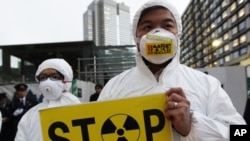Japan's government has announced that the reactors at the nuclear power plant crippled by the March 11th tsunami have achieved conditions of "cold shutdown." But there is a lack of consensus about what that precisely means.
Japan's prime minister, Yoshihiko Noda Friday declared a landmark accomplishment in bringing under control the severely damaged Fukushima-1 nuclear power plant.
The prime minister, at a news conference in Tokyo, says the government can announce that a cold shutdown condition has been reached.
That is supposed to mean the three damaged reactors have been stabilized and are no longer leaking substantial amounts of radiation.
Some are viewing the pronouncement as more political, than scientific, even though Mr. Noda is stressing the nuclear crisis is far from over.
An American engineer who is a specialist in nuclear containment testing, San Diego State University associate professor Murray Jennex, calls Japan's announcement premature.
"If I was in charge I wouldn't be making that statement that they're in cold shutdown. I would say that they're confident that there's no chance of re-criticality and they're going to commence doing clean-up activities," he said. "Here in the [United] States when our nuclear plants are in cold shutdown we actually open up the reactor buildings with free flow of the atmosphere and such."
And that is far from the situation at Fukushima-1, contaminated by high levels of radiation.
That will continue to hamper the clean-up at the facility, which officials and the Tokyo Electric Power Company, the plant's owner, acknowledge could take up to 40 years to complete.
Greenpeace International nuclear campaigner Jan van de Putte, speaking from Brussels, says the Fukushima workers, during the past nine months, have made significant accomplishments but still face an immense and very dangerous job.
"The plant is still leaking. There's still thousands of liters of seriously contaminated water that needs to be treated. Recently there was another crack in that storage of water, leaking into the ocean, with strontium, a very dangerous radioactive substance," he said. "So the plant is far from under control."
Prime Minister Noda, at his news conference, acknowledged the immense challenge of the radiation clean-up and ensuring the public's health. He also alluded to the billions of dollars that will be needed to compensate the tens of thousands of people forced to flee their communities and the numerous ruined businesses, including farms and fishing fleets.
The scientific community has no consensus on just how precarious the situation remains at the Japanese nuclear power facility. That is in part because there is no way to determine whether highly radioactive fuel in the three damaged reactors melted through inner containment vessels and the concrete floor.
Because of that uncertainty, there is also skepticism over whether the government should be attempting to assure the public that the melted cores really pose no risk of a future atomic chain reaction that would again cause them to heat up uncontrollably.
There is also concern about the possibility of another huge quake or tsunami causing cause further serious damage and radiation releases. Authorities in Japan say that is extremely unlikely. But critics point out that Tokyo Electric and the government, before the March 11 earthquake and tsunami, had brushed off warnings that a natural disaster could trigger multiple reactor meltdowns at Fukushima.
Japan Declares Stricken Nuclear Plant Stable







